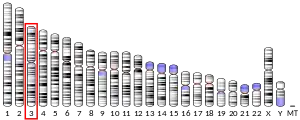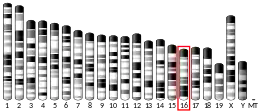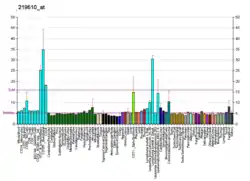POLQ
DNA polymerase theta is an enzyme that in humans is encoded by the POLQ gene.[5][6] This polymerase plays a key role in one of the three major double strand break repair pathways: theta-mediated end joining.[7][8][9][10] Most double-strand breaks are repaired by non-homologous end joining (NHEJ) or homology directed repair (HDR). However, in some contexts, NHEJ and HR are insufficient and TMEJ is the only solution to repair the break.[11] TMEJ is often described as alternative NHEJ, but differs in that it lacks a requirement for the Ku heterodimer, and it can only act on resected DNA ends.[12] Following annealing of short (i.e., a few nucleotides) regions on the DNA overhangs, DNA polymerase theta catalyzes template-dependent DNA synthesis across the broken ends, stabilizing the paired structure.[13][14]
Polymerase theta's mutational signature
TMEJ is intrinsically mutagenic, since polymerase theta uses homologous nucleotides from both break ends to initiate repair, which leads to loss of one set of these nucleotides in the DNA sequence. Therefore, TMEJ is a form of micro-homology mediated end joining (MMEJ). Moreover, when break ends are not stabilized properly, the break ends can detach after polymerization. When these polymerized ends anneal again, a templated insert arises between the deletion junctions.[15]
References
- GRCh38: Ensembl release 89: ENSG00000051341 - Ensembl, May 2017
- GRCm38: Ensembl release 89: ENSMUSG00000034206 - Ensembl, May 2017
- "Human PubMed Reference:". National Center for Biotechnology Information, U.S. National Library of Medicine.
- "Mouse PubMed Reference:". National Center for Biotechnology Information, U.S. National Library of Medicine.
- Sharief FS, Vojta PJ, Ropp PA, Copeland WC (July 1999). "Cloning and chromosomal mapping of the human DNA polymerase theta (POLQ), the eighth human DNA polymerase". Genomics. 59 (1): 90–6. doi:10.1006/geno.1999.5843. PMID 10395804.
- "Entrez Gene: POLQ polymerase (DNA directed), theta".
- Chan SH, Yu AM, McVey M (July 2010). "Dual roles for DNA polymerase theta in alternative end-joining repair of double-strand breaks in Drosophila". PLOS Genetics. 6 (7): e1001005. doi:10.1371/journal.pgen.1001005. PMC 2895639. PMID 20617203.
- Yu AM, McVey M (September 2010). "Synthesis-dependent microhomology-mediated end joining accounts for multiple types of repair junctions". Nucleic Acids Research. 38 (17): 5706–17. doi:10.1093/nar/gkq379. PMC 2943611. PMID 20460465.
- Koole W, van Schendel R, Karambelas AE, van Heteren JT, Okihara KL, Tijsterman M (2014-02-05). "A Polymerase Theta-dependent repair pathway suppresses extensive genomic instability at endogenous G4 DNA sites". Nature Communications. 5 (1): 3216. Bibcode:2014NatCo...5.3216K. doi:10.1038/ncomms4216. PMID 24496117.
- Roerink SF, van Schendel R, Tijsterman M (June 2014). "Polymerase theta-mediated end joining of replication-associated DNA breaks in C. elegans". Genome Research. 24 (6): 954–62. doi:10.1101/gr.170431.113. PMC 4032859. PMID 24614976.
- Schimmel J, van Schendel R, den Dunnen JT, Tijsterman M (September 2019). "Templated Insertions: A Smoking Gun for Polymerase Theta-Mediated End Joining". Trends in Genetics. 35 (9): 632–644. doi:10.1016/j.tig.2019.06.001. PMID 31296341.
- Yousefzadeh MJ, Wyatt DW, Takata K, Mu Y, Hensley SC, Tomida J, et al. (October 2014). "Mechanism of suppression of chromosomal instability by DNA polymerase POLQ". PLOS Genetics. 10 (10): e1004654. doi:10.1371/journal.pgen.1004654. PMC 4183433. PMID 25275444.
- Mateos-Gomez PA, Gong F, Nair N, Miller KM, Lazzerini-Denchi E, Sfeir A (February 2015). "Mammalian polymerase θ promotes alternative NHEJ and suppresses recombination". Nature. 518 (7538): 254–7. Bibcode:2015Natur.518..254M. doi:10.1038/nature14157. PMC 4718306. PMID 25642960.
- Ceccaldi R, Liu JC, Amunugama R, Hajdu I, Primack B, Petalcorin MI, et al. (February 2015). "Homologous-recombination-deficient tumours are dependent on Polθ-mediated repair". Nature. 518 (7538): 258–62. Bibcode:2015Natur.518..258C. doi:10.1038/nature14184. PMC 4415602. PMID 25642963.
- Schimmel J, van Schendel R, den Dunnen JT, Tijsterman M (September 2019). "Templated Insertions: A Smoking Gun for Polymerase Theta-Mediated End Joining". Trends in Genetics. 35 (9): 632–644. doi:10.1016/j.tig.2019.06.001. PMID 31296341.
Further reading
- Hogg M, Sauer-Eriksson AE, Johansson E (March 2012). "Promiscuous DNA synthesis by human DNA polymerase θ". Nucleic Acids Research. 40 (6): 2611–22. doi:10.1093/nar/gkr1102. PMC 3315306. PMID 22135286.
- Robertson NG, Khetarpal U, Gutiérrez-Espeleta GA, Bieber FR, Morton CC (September 1994). "Isolation of novel and known genes from a human fetal cochlear cDNA library using subtractive hybridization and differential screening". Genomics. 23 (1): 42–50. doi:10.1006/geno.1994.1457. PMID 7829101.
- Maga G, Shevelev I, Ramadan K, Spadari S, Hübscher U (May 2002). "DNA polymerase theta purified from human cells is a high-fidelity enzyme". Journal of Molecular Biology. 319 (2): 359–69. doi:10.1016/S0022-2836(02)00325-X. PMID 12051913.
- Seki M, Marini F, Wood RD (November 2003). "POLQ (Pol theta), a DNA polymerase and DNA-dependent ATPase in human cells". Nucleic Acids Research. 31 (21): 6117–26. doi:10.1093/nar/gkg814. PMC 275456. PMID 14576298.
- Kawamura K, Bahar R, Seimiya M, Chiyo M, Wada A, Okada S, et al. (March 2004). "DNA polymerase theta is preferentially expressed in lymphoid tissues and upregulated in human cancers". International Journal of Cancer. 109 (1): 9–16. doi:10.1002/ijc.11666. PMID 14735462. S2CID 19912440.
- Suzuki Y, Yamashita R, Shirota M, Sakakibara Y, Chiba J, Mizushima-Sugano J, et al. (September 2004). "Sequence comparison of human and mouse genes reveals a homologous block structure in the promoter regions". Genome Research. 14 (9): 1711–8. doi:10.1101/gr.2435604. PMC 515316. PMID 15342556.
- Seki M, Masutani C, Yang LW, Schuffert A, Iwai S, Bahar I, Wood RD (November 2004). "High-efficiency bypass of DNA damage by human DNA polymerase Q". The EMBO Journal. 23 (22): 4484–94. doi:10.1038/sj.emboj.7600424. PMC 526458. PMID 15496986.
- Chiapperino D, Cai M, Sayer JM, Yagi H, Kroth H, Masutani C, et al. (December 2005). "Error-prone translesion synthesis by human DNA polymerase eta on DNA-containing deoxyadenosine adducts of 7,8-dihydroxy-9,10-epoxy-7,8,9,10-tetrahydrobenzo[a]pyrene". The Journal of Biological Chemistry. 280 (48): 39684–92. doi:10.1074/jbc.M508008200. PMID 16188888.
- Zan H, Shima N, Xu Z, Al-Qahtani A, Evinger Iii AJ, Zhong Y, et al. (November 2005). "The translesion DNA polymerase theta plays a dominant role in immunoglobulin gene somatic hypermutation". The EMBO Journal. 24 (21): 3757–69. doi:10.1038/sj.emboj.7600833. PMC 1276717. PMID 16222339.
- Cruet-Hennequart S, Coyne S, Glynn MT, Oakley GG, Carty MP (April 2006). "UV-induced RPA phosphorylation is increased in the absence of DNA polymerase eta and requires DNA-PK". DNA Repair. 5 (4): 491–504. doi:10.1016/j.dnarep.2006.01.008. PMID 16520097.
- Chen YW, Cleaver JE, Hanaoka F, Chang CF, Chou KM (April 2006). "A novel role of DNA polymerase eta in modulating cellular sensitivity to chemotherapeutic agents". Molecular Cancer Research. 4 (4): 257–65. doi:10.1158/1541-7786.MCR-05-0118. PMID 16603639.
- Yuasa MS, Masutani C, Hirano A, Cohn MA, Yamaizumi M, Nakatani Y, Hanaoka F (July 2006). "A human DNA polymerase eta complex containing Rad18, Rad6 and Rev1; proteomic analysis and targeting of the complex to the chromatin-bound fraction of cells undergoing replication fork arrest". Genes to Cells. 11 (7): 731–44. doi:10.1111/j.1365-2443.2006.00974.x. PMID 16824193. S2CID 32695133.
- Choi JY, Stover JS, Angel KC, Chowdhury G, Rizzo CJ, Guengerich FP (September 2006). "Biochemical basis of genotoxicity of heterocyclic arylamine food mutagens: Human DNA polymerase eta selectively produces a two-base deletion in copying the N2-guanyl adduct of 2-amino-3-methylimidazo[4,5-f]quinoline but not the C8 adduct at the NarI G3 site". The Journal of Biological Chemistry. 281 (35): 25297–306. doi:10.1074/jbc.M605699200. PMID 16835218.
- Kino K, Ito N, Sugasawa K, Sugiyama H, Hanaoka F (2007). "Translesion synthesis by human DNA polymerase eta across oxidative products of guanine". Nucleic Acids Symposium Series. 48 (48): 171–2. doi:10.1093/nass/48.1.171. PMID 17150533.
- Ewing RM, Chu P, Elisma F, Li H, Taylor P, Climie S, et al. (2007). "Large-scale mapping of human protein-protein interactions by mass spectrometry". Molecular Systems Biology. 3 (1): 89. doi:10.1038/msb4100134. PMC 1847948. PMID 17353931.




